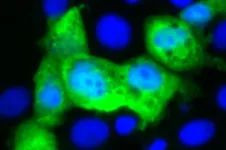(Press-News.org) A new study shows promise for reducing risky drinking among Army National Guard members over the long term, potentially improving their health and readiness to serve.
The number of days each month that Guard members said they had been binge-drinking dropped by up to half, according to the new findings by a University of Michigan team published in the journal Addiction.
The drop happened over the course of a year among Guard members who did multiple brief online education sessions designed for members of the military, and among those who did an initial online education session followed by supportive phone calls every few months with veteran peers trained to talk about alcohol use.
In addition to less binge drinking, the study also showed that both approaches led to lower scores on a scale that measures risky drinking habits. Those who got the peer phone calls over the year also had a reduction on a score that measures alcohol-related impacts on their lives. Those who were randomly assigned to receive no support beyond a pamphlet saw no decline by the end of the year on any of the measures.
“This is the first study of its kind to show the effectiveness of a relatively inexpensive e-health intervention for hazardous alcohol use in a component of our nation’s Army reserves,” says Frederic Blow, Ph.D., lead author of the study and the director of the University of Michigan Addiction Center. “With risky drinking threatening the health and readiness of those who serve, we hope this approach could be useful in other National Guard units and beyond.”
Focusing on those most at risk
The randomized controlled trial, called Mission Strong, grew out of previous work that showed the power of tailored education and peer support in reducing risking drinking among veterans who receive care at Veterans Affairs medical centers.
The U-M team had also done a previous survey that showed that nearly a third of Michigan Army National Guard members who had deployed as part of their service showed signs of risky drinking. Other research has shown that National Guard members who have deployed have higher rates of risky drinking than active duty members of other branches of the military who have deployed.
The Mission Strong study involved members of 41 Michigan Guard units who took surveys about their alcohol use during one of their monthly drill weekends. Of the 2,746 screened, 832 (30%) scored high enough to be considered to have hazardous alcohol use.
“We’re so grateful for the cooperation and ongoing engagement by the Michigan Army National Guard, which is working to improve the health and readiness of its members and made it possible for us to do a study that could help many other Guard units nationwide,” says senior author Lara Coughlin, Ph.D., an addiction psychologist and researcher at U-M and Addiction Center member who also sees patients at U-M Addiction Treatment Services.
The 739 Guard members who agreed to be randomly assigned to one of the three groups had an average age of 28, and 16% were women. While the majority were white and not of Hispanic backgrounds, 12% were Hispanic and 10% were Black. Just over 10% used cannabis despite the fact that it is against National Guard policy and was not generally legal in Michigan at the time of the study.
On mental health surveys, 10% reported they had had thoughts of suicide, 19% had moderate to severe depression, and nearly 5% had a score high enough to qualify for a diagnosis of post-traumatic stress disorder.
The study focused on National Guard members because of the unique nature of their service as citizen soldiers, who live in the community and work or study most of the time but drill regularly and are available to be called up for service to the state or nation.
Among those in the study, 84% were employed full or part time, and 49% had ever been deployed as part of their Guard service. Just over half had an enlisted rank of private or corporal, with most of the rest having higher enlisted ranks; 6% were officers.
By the end of a year, 550 of them had completed all three follow-up surveys, including 142 who had taken part in three phone calls from peers, 120 who had completed three follow-up web-based sessions, and the remainder who had only received the information pamphlet at the drill weekend and completed three follow-up surveys. All received a small amount of money for participating, to compensate them for their time.
Binge-drinking was defined as six or more drinks in one sitting by men, and four or more by women. Their overall hazardous alcohol use level was measured using the AUDIT scale and the consequences of their drinking habits in their lives – from relationships and finances to risk-taking and accidents -- was measured using the SIP survey.
Results of the study
At the start of the study, participants reported binge-drinking four to five days a month. By the end, those in the peer-support group had gone from 5.2 days to 2.6 days on average, while those in the online education only group had gone from 4.2 days to 2.8 days on average. Those in the third group were still binge-drinking 4 days a month by the end of the study period.
On the AUDIT scale of risky drinking, those who received the peer calls had a 3.6-point reduction over the course of the year on average, while those who received online-only contacts had a nearly three-point drop – both considered significantly larger than the two-point drop among those who only received a pamphlet and follow-up surveys. At the start of the study, the average score for all three groups was above 9, indicating hazardous drinking; by the end the average score for the two groups that received the tailored online education had dropped below the hazardous threshold while the group that received no online education was still at hazardous levels.
On the SIP scale of the impacts of alcohol on a person’s life, those who received peer calls were the only ones to have a significant change from the start of the study to the end.
In addition to Coughlin, who is an assistant professor of psychiatry, and Blow, who is a professor of psychiatry in the U-M Medical School, the study’s authors are Maureen Walton, Ph.D., Mark Ilgen, Ph.D., and Kristen Barry, Ph.D. of the Addiction Center and Department of Psychiatry; Heather Walters of VA Ann Arbor Healthcare System; Lynn Massey of the U-M Injury Prevention Center; statistician Rosalinda Ignacio of the U-M School of Public Health; and Richard McCormick, Ph.D., of Case Western Reserve University.
Blow, Coughlin, Ilgen, Walton and Barry are also members of the U-M Injury Prevention Center and Institute for Healthcare Policy and Innovation.
The study was funded by the National Institute on Alcohol Abuse and Alcoholism (AA023122).
Details about the Mission Strong study are available via its listing on Clinicaltrials.gov (NCT02181283)
Peer- and web-based interventions for risky drinking among US National Guard members: Mission Strong randomized controlled trial, Addiction, 2023. https://doi.org/10.1111/add.16172
END
Education and peer support cut binge-drinking by National Guard members in half, study shows
With hazardous alcohol use threatening military readiness, randomized trial finds tailored education and peer support leads to sustained drop in risky drinking
2023-04-12
ELSE PRESS RELEASES FROM THIS DATE:
World’s biggest cumulative logjam, newly mapped in the Arctic, stores 3.4 million tons of carbon
2023-04-11
WASHINGTON — Throughout the Arctic, fallen trees make their way from forests to the ocean by way of rivers. Those logs can stack up as the river twists and turns, resulting in long-term carbon storage. A new study has mapped the largest known woody deposit, covering 51 square kilometers (20 square miles) of the Mackenzie River Delta in Nunavut, Canada, and calculated that the logs store about 3.4 million tons (about 3.1 million metric tons) of carbon.
“To put that in perspective, that’s about two and a half million ...
Life cycle assessment can help with the transition to the circular economy
2023-04-11
According to Bening Mayanti's doctoral dissertation at the University of Vaasa, the use of life cycle assessment combined with economic models can help companies to take steps toward the circular economy.
– We often hear claims about some solutions being circular, sustainable, or green. Instead of blindly accepting those claims, we should ask justifications, ‘How so?’ says Mayanti, who publicly defended her dissertation on Wednesday, 5 April.
Before deciding on circular economy solutions and building supply chains, it is worth doing a careful analysis. ...
From waste to wonder: unlocking nature’s biochemical recycling secrets
2023-04-11
A new perspective published in the journal Nature Chemical Biology uncovers a previously unknown biochemical recycling process in animals. The authors review a flurry of recent papers demonstrating that animals extensively recycle biochemical waste to produce novel chemicals that play key roles in biology, from regulating behavior to development and aging.
These studies show that the genes previously thought to code for carboxylesterases, enzymes that hydrolyze esters, actually play a pivotal role in assembling a wide range of new metabolites from building blocks generally considered “cellular waste.” Surprisingly, the so-called carboxylesterases were found to contribute ...
Yossi Sheffi on AI and the future of the supply chain
2023-04-11
Global supply chains are immense feats of technological and organizational sophistication. They are also, as the onset of the Covid-19 pandemic showed, vulnerable to unexpected developments. Will that change as artificial intelligence becomes a bigger part of supply chains? And what will happen to workers in the process?
MIT Professor Yossi Sheffi explores these topics in a new book, “The Magic Conveyor Belt: AI, Supply Chains, and the Future of Work,” published by MIT’s CTL Media. Sheffi, the Elisha Gray II Professor of Engineering ...
Tax credit tool tracks EV savings
2023-04-11
Oak Ridge National Laboratory researchers have developed an online resource to help consumers understand the electric vehicle tax credits available through the Inflation Reduction Act.
Located on the Department of Energy’s fueleconomy.gov website, the tool shows eligible vehicle models along with the corresponding federal tax credit.
The new clean vehicle tax credit is for purchases of all-electric, plug-in hybrid electric and fuel cell electric vehicles in 2023 and beyond. A separate credit is available for eligible used vehicles purchased in 2023 or after. Information on credits for vehicles purchased before ...
Knockout of AMD-associated gene POLDIP2 reduces mitochondrial superoxide in retinal cells
2023-04-11
“To our knowledge, this is the first functional study of POLDIP2 in retinal cells to understand its potential role in AMD.”
BUFFALO, NY- April 11, 2023 – A new research paper was published in Aging (listed by MEDLINE/PubMed as "Aging (Albany NY)" and "Aging-US" by Web of Science) Volume 15, Issue 6, entitled, “Knockout of AMD-associated gene POLDIP2 reduces mitochondrial superoxide in human retinal pigment epithelial cells.”
Genetic and epidemiologic studies have significantly advanced our ...
New approach targets norovirus, world’s leading cause of foodborne infection
2023-04-11
Every year, norovirus causes hundreds of millions of cases of food poisoning — and the deaths of at least 50,000 children — yet there exists no real way to control it. The virus has proven exceptionally difficult to study in the lab, and scientists have struggled to develop effective vaccines and drugs.
A new study at Washington University School of Medicine in St. Louis describes a creative way to make a vaccine against norovirus by piggybacking on the highly effective vaccines for rotavirus, an unrelated virus that also causes diarrhea.
The ...
Electrification push will have enormous impacts on critical metals supply chain
2023-04-11
ITHACA, N.Y. – The demand for battery-grade lithium, nickel, cobalt, manganese and platinum will climb steeply as vehicle electrification speeds up and nations work to reduce greenhouse gas emissions through mid-century. This surge in demand will also create a variety of economic and supply-chain problems, according to new Cornell University research published in Nature Communications.
In the new paper, senior author Fengqi You, professor in energy systems engineering, and his colleagues examined 48 countries that are committed to playing a strong role in electrifying transportation, including the U.S., China and India.
Under ...
Takeda licenses small molecule developed by Krembil Brain Institute researchers, targeting tau protein implicated in Alzheimer’s disease
2023-04-11
As announced today in a press release by biotechnology company Treventis, global pharmaceutical company Takeda has agreed to exclusively license a group of small molecules that target tau – a protein in which misfolding and aggregation are believed to be a cause of Alzheimer’s disease.
The molecules were developed by the team at Treventis, building upon the Alzheimer’s & neurodegenerative research expertise of Dr. Donald Weaver’s lab at UHN.
“There are currently no effective drugs out there that target tau in the brain,” says Dr. Donald Weaver, Senior ...
Mount Sinai researchers discover novel receptors for SARS-CoV-2 and their age-dependent expression, providing new insights for public health
2023-04-11
New York, NY (April 11, 2023) – A study led by Mount Sinai researchers Dr. Bin Zhang, the Willard T.C. Johnson Research Professor of Neurogenetics, and Dr. Christian Forst, an Associate Professor in the Department of Genetics and Genomic Sciences, have identified potential novel receptors for SARS-CoV-2 and unveiled their tissue-specific and age-dependent expression. The findings were published on March 23 in the Federation of European Biochemical Societies Letters.
The study's multiscale network analysis suggests that SARS-CoV-2 utilizes multiple novel receptors, such as the TYOBP receptor CD300e, to facilitate ...
LAST 30 PRESS RELEASES:
Injectable breast ‘implant’ offers alternative to traditional surgeries
Neuroscientists devise formulas to measure multilingualism
New prostate cancer trial seeks to reduce toxicity without sacrificing efficacy
Geometry shapes life
A CRISPR screen reveals many previously unrecognized genes required for brain development and a new neurodevelopmental disorder
Hot flush treatment has anti-breast cancer activity, study finds
Securing AI systems against growing cybersecurity threats
Longest observation of an active solar region
Why nail-biting, procrastination and other self-sabotaging behaviors are rooted in survival instincts
Regional variations in mechanical properties of porcine leptomeninges
Artificial empathy in therapy and healthcare: advancements in interpersonal interaction technologies
Why some brains switch gears more efficiently than others
UVA’s Jundong Li wins ICDM’S 2025 Tao Li Award for data mining, machine learning
UVA’s low-power, high-performance computer power player Mircea Stan earns National Academy of Inventors fellowship
Not playing by the rules: USU researcher explores filamentous algae dynamics in rivers
Do our body clocks influence our risk of dementia?
Anthropologists offer new evidence of bipedalism in long-debated fossil discovery
Safer receipt paper from wood
Dosage-sensitive genes suggest no whole-genome duplications in ancestral angiosperm
First ancient human herpesvirus genomes document their deep history with humans
Why Some Bacteria Survive Antibiotics and How to Stop Them - New study reveals that bacteria can survive antibiotic treatment through two fundamentally different “shutdown modes”
UCLA study links scar healing to dangerous placenta condition
CHANGE-seq-BE finds off-target changes in the genome from base editors
The Journal of Nuclear Medicine Ahead-of-Print Tip Sheet: January 2, 2026
Delayed or absent first dose of measles, mumps, and rubella vaccination
Trends in US preterm birth rates by household income and race and ethnicity
Study identifies potential biomarker linked to progression and brain inflammation in multiple sclerosis
Many mothers in Norway do not show up for postnatal check-ups
Researchers want to find out why quick clay is so unstable
Superradiant spins show teamwork at the quantum scale
[Press-News.org] Education and peer support cut binge-drinking by National Guard members in half, study showsWith hazardous alcohol use threatening military readiness, randomized trial finds tailored education and peer support leads to sustained drop in risky drinking





